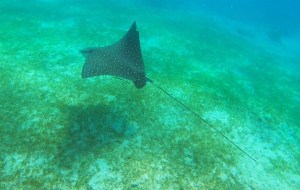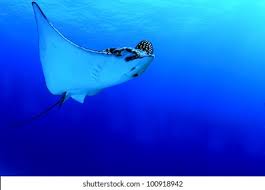Eagle Rays: Graceful Guardians of the Ocean
Eagle Rays: Majestic Creatures of the Ocean
Eagle rays, with their graceful movements and distinctive shapes, are among the most captivating creatures inhabiting the world’s oceans. These majestic rays belong to the family Myliobatidae and are known for their distinctive flattened bodies, elongated snouts, and wing-like pectoral fins, resembling the outstretched wings of an eagle in flight, hence their name. Delving deeper into their characteristics, behavior, habitat, and significance unveils a fascinating tapestry of marine life.

A majestic Eagle ray in motion
Physical Characteristics
Eagle rays possess a unique set of physical attributes that distinguish them from other marine species. Their bodies are flattened, disc-shaped, and adorned with patterns of spots and markings that aid in camouflage and identification. Typically, eagle rays boast elongated, pointed snouts equipped with electroreceptors that help them detect prey buried in the sandy ocean floor.
One of the most striking features of eagle rays is their expansive pectoral fins, which extend outward like wings, giving them an appearance of flying through the water. These fins enable them to glide effortlessly, performing elegant maneuvers as they navigate the ocean depths. Their tails, often equipped with venomous spines, serve as defense mechanisms against potential predators and are used for propulsion.
Habitat and Distribution
Eagle rays are found in various marine habitats worldwide, preferring warm tropical and subtropical waters. They inhabit coastal regions, coral reefs, and sandy bottoms, where they forage for food and seek shelter. From the azure waters of the Caribbean to the vibrant reefs of the Indo-Pacific, eagle rays can be spotted in a diverse array of ecosystems.
These rays are highly adaptable and can thrive in both shallow and deep waters, depending on the availability of food and environmental conditions. While some species prefer shallow coastal areas, others venture into deeper offshore regions in search of prey and suitable breeding grounds.
Behavior and Feeding Habits
Eagle rays are primarily solitary creatures, though they may congregate in small groups during mating seasons or while foraging for food. Their feeding habits are varied, encompassing a diet consisting of crustaceans, mollusks, small fish, and benthic invertebrates. Using their electroreceptive abilities and keen senses, they scour the ocean floor, using their specialized mouths to sift through sediment in search of buried prey.
These rays employ a distinctive feeding technique known as “pouncing,” where they swiftly dive down to the seafloor, flap their wings to stir up sediment, and capture unsuspecting prey with their protruding jaws. This method allows them to efficiently locate and consume prey while minimizing energy expenditure.

A beautiful Eagle ray gliding through the water
Reproduction and Life Cycle
Like many elasmobranchs, eagle rays exhibit ovoviviparous reproduction, whereby embryos develop within egg capsules inside the mother’s body until they are ready to hatch. After a gestation period ranging from several months to over a year, depending on the species, female eagle rays give birth to live offspring known as pups.
The number of pups per litter varies among species, with some producing only one or two offspring per reproductive cycle. Once born, the young eagle rays are self-sufficient and must fend for themselves in their natural habitat. They undergo a period of rapid growth and maturation, eventually reaching sexual maturity and perpetuating the cycle of life.
Ecological Significance and Conservation
Eagle rays play a crucial role in maintaining the ecological balance of marine ecosystems. As apex predators, they help regulate the populations of their prey species, preventing overpopulation and promoting biodiversity. By controlling the abundance of benthic organisms and small fish, they indirectly influence the health and stability of coral reefs and coastal habitats.
Despite their ecological importance, eagle rays face numerous threats that jeopardize their survival. Habitat degradation, pollution, overfishing, and accidental bycatch pose significant challenges to their populations worldwide. Additionally, the demand for their meat, fins, and skin in certain regions has led to targeted fishing activities, resulting in declines in some eagle ray populations.
Conservation efforts aimed at protecting eagle rays and their habitats are essential for ensuring their long-term survival. Establishing marine protected areas, implementing sustainable fishing practices, and raising public awareness about the importance of these magnificent creatures are crucial steps toward safeguarding their future.
In conclusion, eagle rays stand as iconic symbols of the ocean’s beauty and diversity, captivating the imaginations of marine enthusiasts and scientists alike. From their graceful movements to their vital ecological roles, these remarkable rays exemplify the wonders of the underwater world. As stewards of our planet’s oceans, it is our collective responsibility to preserve and cherish these majestic creatures for generations to come.
- Posted in:
- Aquatic Ecology
- Marine Life
- Ocean Conservation
